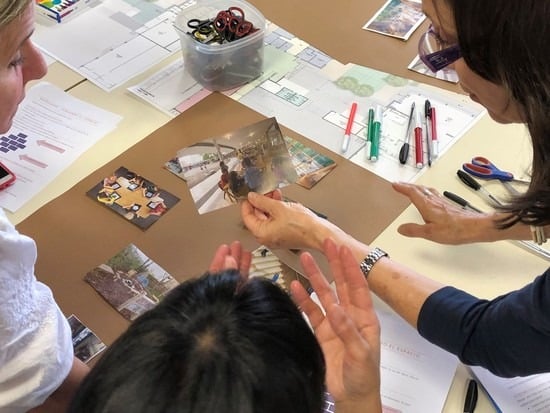Crossing Contexts: Applying a System for Collaborative Investigation of School Space to Inform Design Decisions in Contrasting Settings
Abstract
:1. Introduction
1.1. Troubles with Transfer
1.1.1. Architecture
1.1.2. Education
Though there are undoubted cross-cultural continuities and indeed universals in educational thinking and practice, no decision or action which one observes in a particular classroom, and no educational policy, can be properly understood except by reference to the web of inherited ideas and values, habits and customs, institutions and world views which make one country, or one region, or one group, distinct from another.([12], p. 5)
1.2. Perils of Participation
2. Materials and Methods: Our System
3. Results: Use of the System within Two Contrasting Contexts
3.1. In England
3.2. In Uruguay
4. Discussion and Conclusions
Author Contributions
Funding
Conflicts of Interest
References
- Lawson, B. How Designers Think. The Design Process Demystified, 4th ed.; Architectural Press: Abingdon, UK, 2005. [Google Scholar]
- Lawson, B. Schemata, gambits and precedent: Some factors in design expertise. Des. Stud. 2004, 25, 443–457. [Google Scholar] [CrossRef] [Green Version]
- Rosero, V. Modernity, guilty? The role of architecture in social housing. Pruitt-Igoe as a symbol. Rita 2017, 8, 126–135. [Google Scholar]
- Nisivoccia, E.; Craciun, M.; Gambini, J.; Medero, S.; Méndez, M.; Nudelman, J. La aldea Feliz. Episodios de la modernización en el Uruguay; Ministerio de Educación y Cultura, Ministerio de Relaciones Exteriores, Universidad de la República: Montevideo, Uruguay, 2014; 342p. [Google Scholar]
- Jamieson, P.; Fisher, K.; Gilding, T.; Taylor, P.G.; Trevitt, A.C.F. Place and Space in the Design of New Learning Environments. High. Educ. Res. Dev. 2000, 19, 221–236. [Google Scholar] [CrossRef]
- Abassi, N. Pathways to a Better Personal and Social Life through Learning Spaces: The Role of School Design in Adolescents’ Identity Formation, in Faculty of Architecture, Building and Planning. Ph.D. Thesis, University of Melbourne, Melbourne, Australia, 2009. [Google Scholar]
- Malaguzzi, L.; Zini, M. Children, Spaces, Relations: Metaproject for Environment for Young Children; Ceppi, G., Zini, M., Eds.; Grafiche Rebecchi Ceccarelli: Modena, Italy, 1998. [Google Scholar]
- Morgan, J. Critical pedagogy: The spaces that make the difference. Pedagog. Cult. Soc. 2000, 8, 273–289. [Google Scholar] [CrossRef] [Green Version]
- Higgins, S.; Hall, E.; Wall, K.; Woolner, P.; McCaughey, C. The Impact of School Environments: A Literature Review; Design Council: London, UK, 2005. [Google Scholar]
- Whyte, J.; Cardellino, P. Learning by Design: Visual Practices and Organizational Transformation in Schools. Des. Issues 2010, 26, 59–69. [Google Scholar] [CrossRef]
- Hantrais, L. Contextualization in cross-national comparative research. Int. J. Soc. Res. Methodol. 1999, 2, 93–108. [Google Scholar] [CrossRef]
- Alexander, R.J. Culture and Pedagogy: International Comparisons in Primary Education; Wiley-Blackwell: Malden, MA, USA, 2001. [Google Scholar]
- May, J. A History of Australian Schooling. Hist. Educ. Rev. 2014, 43, 260–262. [Google Scholar]
- Chisholm, L.; Leyendecker, R. Curriculum reform in post-1990s sub-Saharan Africa. Int. J. Educ. Dev. 2008, 28, 195–205. [Google Scholar] [CrossRef]
- Khormi, S.; Woolner, P. Development of Saudi Mathematics Curriculum between Hope and Reality. Int. J. Manag. Appl. Sci. 2019, 5, 26–36. [Google Scholar]
- Alexander, R. Evidence, rhetoric and collateral damage: The problematic pursuit of ‘world class’ standards. Camb. J. Educ. 2011, 41, 265–286. [Google Scholar] [CrossRef]
- Auld, E.; Morris, P. Comparative education, the ‘New Paradigm’ and policy borrowing: Constructing knowledge for educational reform. Comp. Educ. 2014, 50, 129–155. [Google Scholar] [CrossRef]
- Clapham, A.; Vickers, R. Neither a borrower nor a lender be: Exploring ‘teaching for mastery’ policy borrowing. Oxf. Rev. Educ. 2018, 44, 787–805. [Google Scholar] [CrossRef] [Green Version]
- Uduku, O. The Nigerian ‘Unity Schools’ project: A UNESCO-IDA school building programme in Africa. In Designing Schools: Space, Place and Pedagogy; Darian, S., Willis, J., Eds.; Routledge: New York, NY, USA, 2017; pp. 175–187. [Google Scholar]
- Wood, A. Built policy: School-building and architecture as policy instrument. J. Educ. Policy 2020, 35, 465–484. [Google Scholar]
- Sanoff, H. Designing a Responsive School: Benefits of a Participatory Process. Sch. Adm. 1996, 53, 18–22. [Google Scholar]
- Gislason, N. The Open Plan High School: Educational Motivations and Challenges. In School Design Together; Routledge: London, UK, 2015; pp. 101–120. [Google Scholar]
- Carvalho, L.; Yeoman, P. Framing learning entanglement in innovative learning spaces: Connecting theory, design and practice. Br. Educ. Res. J. 2018, 44, 1120–1137. [Google Scholar] [CrossRef]
- Blackmore, J.; Bateman, D.; Loughlin, J.; O’Mara, J.; Aranda, G. Research into the Connection Between Built Learning Spaces and Student Outcomes; Education Policy and Research Division, Department of Education and Early Childhood Developmen: Melbourne, Australia, 2011.
- Gislason, N. The Whole School: Planning and Evaluating Innovative Middle and Secondary Schools. In School Space and Its Occupation: Conceptualising and Evaluating Innovative Learning Environments; Alterator, S., Deed, C., Eds.; Brill/Sense: Amsterdam, The Netherlands, 2018. [Google Scholar]
- Sigurðardóttir, A.K.; Hjartarson, T. The Idea and Reality of an Innovative School: From Inventive Design to Established Practice in a New School Building. Improv. Sch. 2016, 19, 62–79. [Google Scholar] [CrossRef]
- Uline, C.L. Decent Facilities and Learning: Thirman A. Milner Elementary School and Beyond. Teach. Coll. Rec. 2000, 102, 442–460. [Google Scholar] [CrossRef]
- Cardellino, P.; Woolner, P. Designing for transformation–a case study of open learning spaces and educational change. Pedagog. Cult. Soc. 2020, 28, 383–402. [Google Scholar] [CrossRef]
- Woolner, P.; Clark, J.; Laing, K.; Thomas, U.; Tiplady, L. A school tries to change: How leaders and teachers understand changes to space and practices in a UK secondary school. Improv. Sch. 2014, 17, 148–162. [Google Scholar]
- Parnell, R. Co-creative Adventures in School Design. In School Design Together; Woolner, P., Ed.; Routledge: London, UK, 2015; pp. 167–183. [Google Scholar]
- Graue, E.; Hatch, K.; Rao, K.; Oen, D. The wisdom of class-size reduction. Am. Educ. Res. J. 2007, 44, 670–700. [Google Scholar] [CrossRef] [Green Version]
- Imms, W. Innovative Learning Spaces: Catalysts/Agents for Change, or ‘Just Another Fad’? In School Space and Its Occupation: Conceptualising and Evaluating Innovative Learning Environments; Deed, S.A.C., Ed.; Brill/Sense: Amsterdam, The Netherlands, 2018. [Google Scholar]
- Lackney, J. Teacher Environmental Competence in Elementary School Environments. Child. Youth Environ. 2008, 18, 133–159. [Google Scholar]
- Parnell, R.; Cave, V.; Torrington, J. School Design: Opportunities through Collaboration. CoDesign 2008, 4, 211–224. [Google Scholar] [CrossRef]
- Mulcahy, D.; Cleveland, B.; Aberton, H. Learning Spaces and Pedagogic Change: Envisioned, Enacted and Experienced. Pedagog. Cult. Soc. 2015, 23, 575–595. [Google Scholar] [CrossRef]
- Saltmarsh, S.; Chapman, A.; Campbell, M.; Drew, C. Putting “structure within the Space”: Spatially Un/responsive Pedagogic Practices in Open-plan Learning Environments. Educ. Rev. 2015, 67, 315–327. [Google Scholar] [CrossRef]
- Allen, L. ’Snapped’: Researching the sexual cultures of schools using visual methods. Int. J. Qual. Methods Educ. 2009, 22, 549–561. [Google Scholar] [CrossRef]
- Darbyshire, P.; Macdougall, C.; Schiller, W. Multiple methods in qualitative research with children: More insight or just more? Qual. Res. 2005, 5, 417–436. [Google Scholar] [CrossRef] [Green Version]
- Harper, D. Talking about pictures: A case for photo elicitation. Vis. Stud. 2002, 17, 13–26. [Google Scholar] [CrossRef]
- Woolner, P.; Clark, J.; Hall, E.; Tiplady, L.; Thomas, U.; Wall, K. Pictures are necessary but not sufficient: Using a range of visual methods to engage users about school design. Learn. Environ. Res. 2010, 13, 1–22. [Google Scholar] [CrossRef]
- Niemi, R.L.M.; Kumpulainen, K.; Lipponen, L.; Hilppö, J. Pupils’ perspectives on the lived pedagogy of the classroom. Educ. Rev. 2015, 43, 683–699. [Google Scholar] [CrossRef]
- Prosser, J. Visual methods and the visual culture of schools. Vis. Stud. 2007, 22, 13–30. [Google Scholar] [CrossRef]
- Halpin, D. Utopian Spaces of “Robust Hope”: The architecture and nature of progressive learning environments. Asia-Pac. J. Teach. Educ. 2007, 35, 243–255. [Google Scholar] [CrossRef]
- Wilkinson, C.; Carter, B.; Satchwell, C.; Bray, L. Using methods across generations: Researcher reflections from a research project involving young people and their parents. Child. Geogr. 2021. [Google Scholar] [CrossRef]
- Ball, S.J. The Education Debate, 3rd ed.; The Policy Press: Bristol, UK, 2017. [Google Scholar]
- Saint, A. Towards a Social Architecture; Bath Press: Avon, UK, 1987. [Google Scholar]
- ANEP. Ordenanza 14. Normas de Habilitación de Establecimientos Privados de Educación; Administración Nacional de Educación Pública: Montevideo, Uruguay, 1995.
- French, R.; Imms, W.; Mahat, M. Case studies on the transition from traditional classrooms to innovative learning environments: Emerging strategies for success. Improv. Sch. 2019, 23, 1–15. [Google Scholar] [CrossRef]
- Thomson, P.; Hall, C. Place-Based Methods for Researching Schools; Bloomsbury: London, UK, 2017. [Google Scholar]
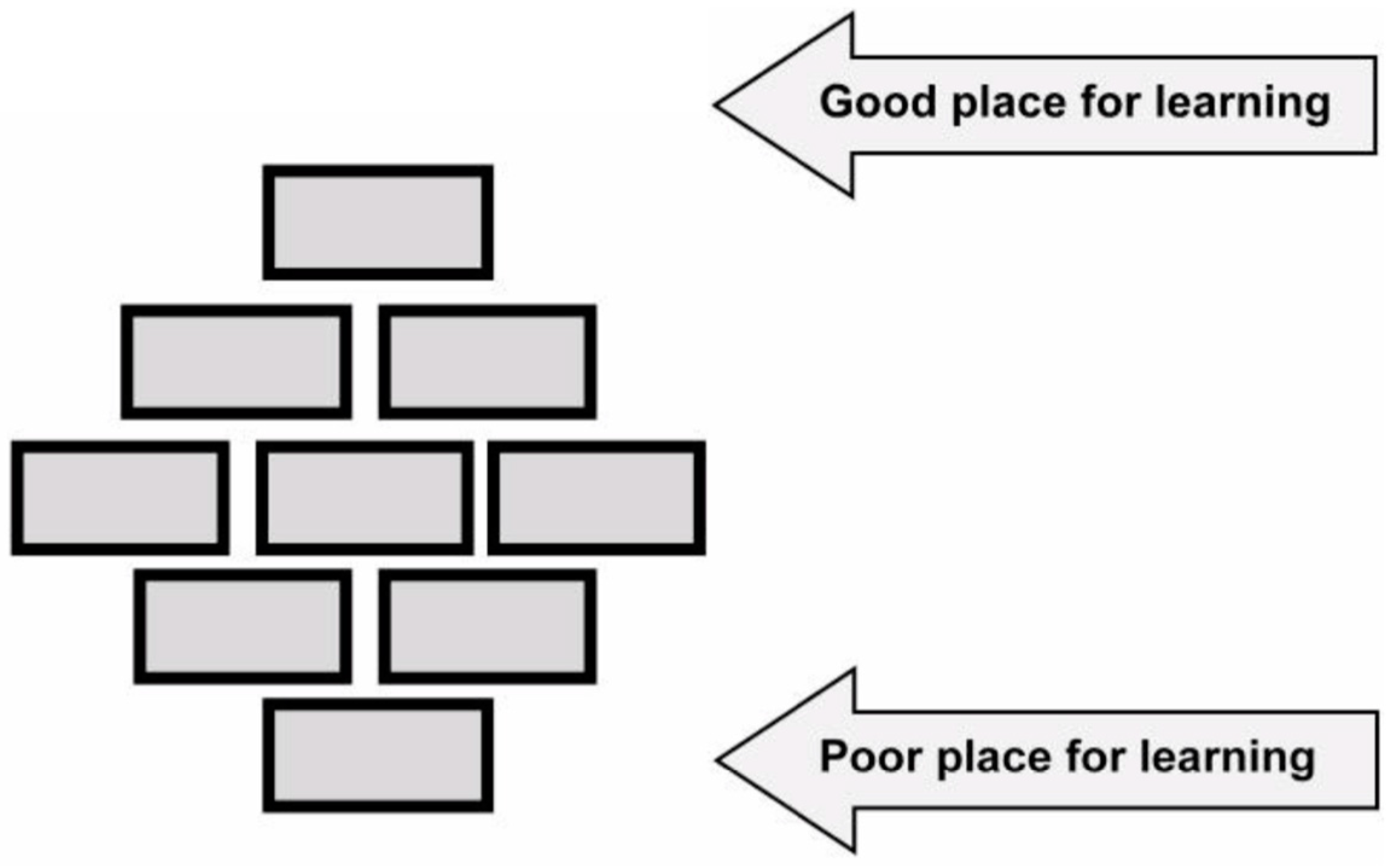
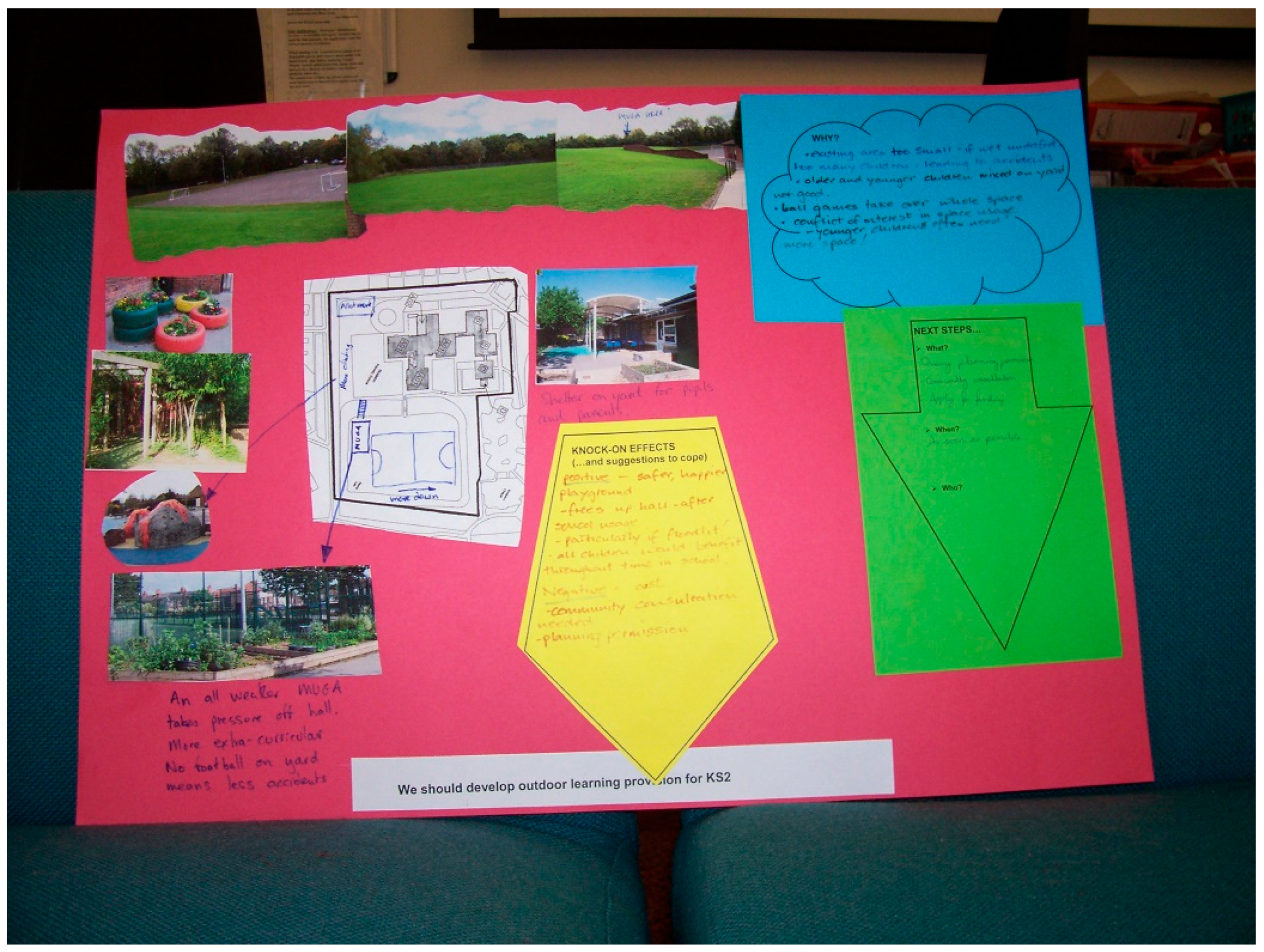



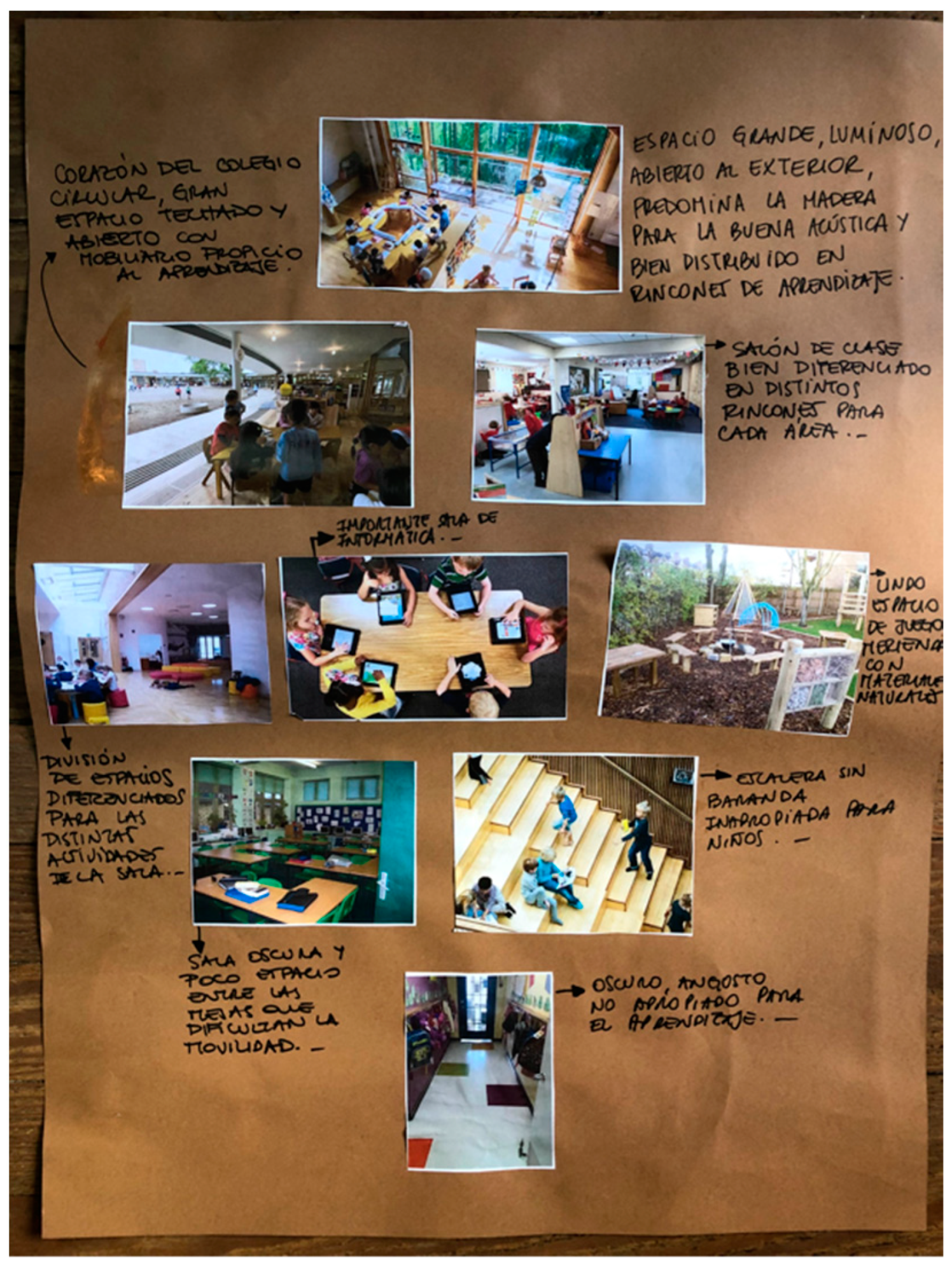
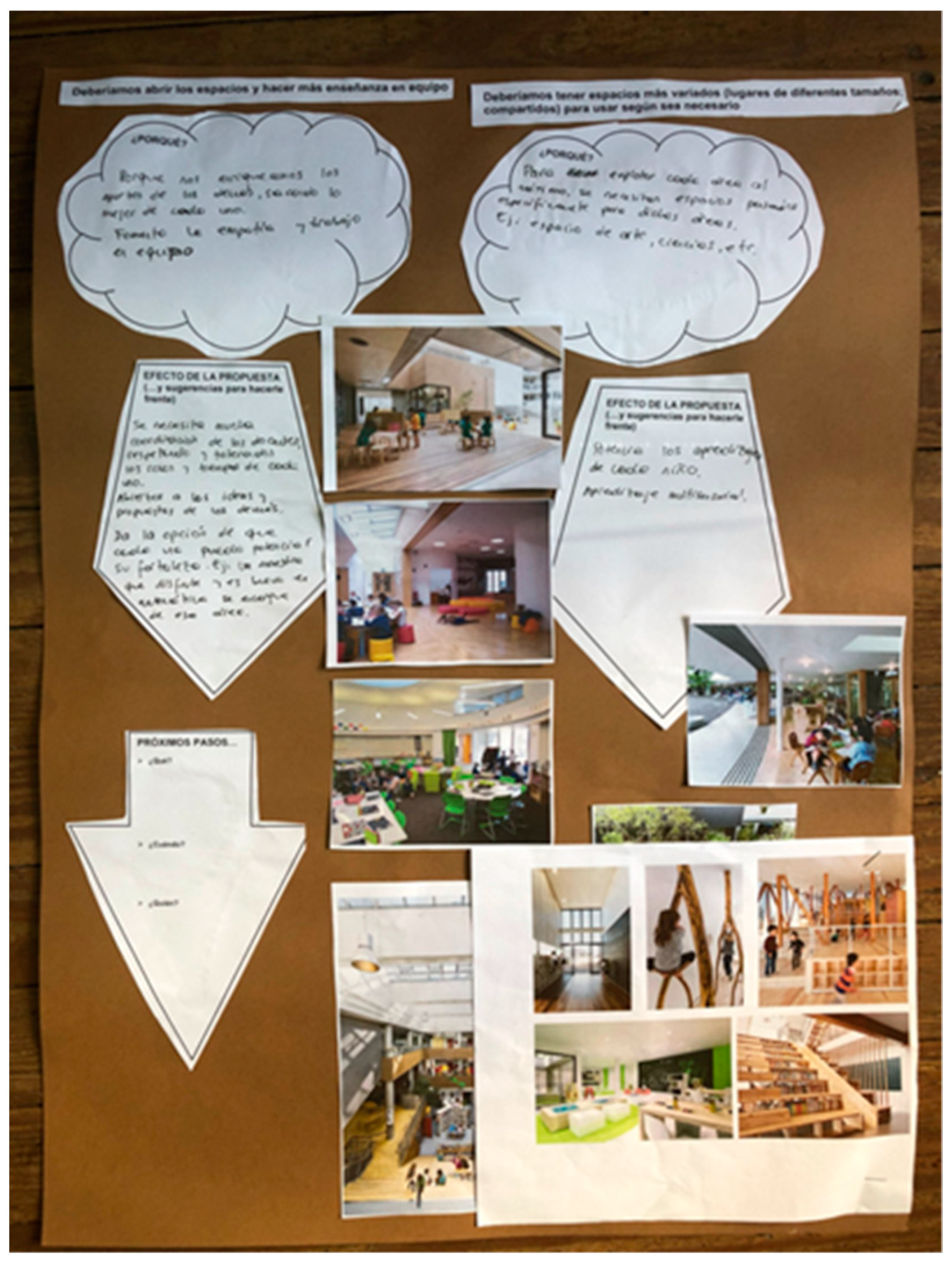
Publisher’s Note: MDPI stays neutral with regard to jurisdictional claims in published maps and institutional affiliations. |
© 2021 by the authors. Licensee MDPI, Basel, Switzerland. This article is an open access article distributed under the terms and conditions of the Creative Commons Attribution (CC BY) license (https://creativecommons.org/licenses/by/4.0/).
Share and Cite
Woolner, P.; Cardellino, P. Crossing Contexts: Applying a System for Collaborative Investigation of School Space to Inform Design Decisions in Contrasting Settings. Buildings 2021, 11, 496. https://doi.org/10.3390/buildings11110496
Woolner P, Cardellino P. Crossing Contexts: Applying a System for Collaborative Investigation of School Space to Inform Design Decisions in Contrasting Settings. Buildings. 2021; 11(11):496. https://doi.org/10.3390/buildings11110496
Chicago/Turabian StyleWoolner, Pamela, and Paula Cardellino. 2021. "Crossing Contexts: Applying a System for Collaborative Investigation of School Space to Inform Design Decisions in Contrasting Settings" Buildings 11, no. 11: 496. https://doi.org/10.3390/buildings11110496
APA StyleWoolner, P., & Cardellino, P. (2021). Crossing Contexts: Applying a System for Collaborative Investigation of School Space to Inform Design Decisions in Contrasting Settings. Buildings, 11(11), 496. https://doi.org/10.3390/buildings11110496






